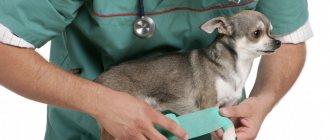Have you ever wondered why dogs go blind? It's common to talk about blindness in older or older dogs, but sudden vision loss in puppies or young dogs isn't always easy to come to terms with. However, it is important to note that, unlike humans, dogs' vision is not as important as their sense of smell or touch. Did you know?
In this article, we'll talk about how to tell if a dog is blind, the causes of sudden blindness in dogs, the most common symptoms of blindness in dogs, and much more. Don't forget to visit a veterinary ophthalmologist to get individual, high-quality advice.
Uveitis - inflammation of the eye
There are many reasons that can cause blindness in a dog. We sometimes talk about this as a relatively normal sign in older dogs, but it can also be a symptom of a more serious secondary condition beyond blindness, such as kidney failure, a case of chronic kidney disease causing metabolic problems. In this case, blindness would be an inevitable consequence.
Since the causes of blindness in dogs can vary widely, a proper veterinary examination is ideally recommended. Remember that some systemic diseases such as ehrlichiosis, babesiosis, toxoplasmosis, leptospirosis, leishmaniasis and many others can cause blindness.
© shutterstock
Diagnostics
It is impossible to subjectively determine an animal’s visual acuity using “human” tables with letters and numbers. In the practice of ophthalmic veterinary medicine, objective examination methods are used:
- checking the light reflex of the pupils;
- testing of tear ducts;
- examination of the eyeballs;
- fluorescein staining of the cornea;
- tonometry;
- biomicroscopy using a slit lamp.
Additional diagnostic methods include:
- neurological examination;
- visual test of the dog on the obstacle course;
- blood tests (clinical and serological);
- electroretinography;
- cytological examination of fragments of the conjunctiva and cornea;
- spinal tap;
- MRI, CT, ultrasound.
Early detection of the disease increases the chances of preventing complete loss of vision in your dog. Therefore, a visit to a medical facility should be scheduled at the first symptoms of impending blindness.
Why does my dog have blue eyes?
The eyes are responsible, in addition to capturing images and transmitting them to the brain, for controlling the passage of light, as well as other functions. It is important to note that a small change can damage the eyes, sometimes permanently, leaving the animal blind.
When a dog has blue eyes, we are not necessarily talking about blindness, however, if nothing is done to treat it, blindness can occur eventually and irreversibly. A bluish color, like any other color change, indicates inflammation of the layer of the eye (anatomically we are talking about the choroid), and that is when we talk about uveitis in dogs.
Uveitis can be caused by bacterial infections, viral infections, trauma, or lack of tear production, causing dryness of the cornea and subsequent inflammation of the eye. It usually affects one eye, and if treated early, uveitis should not cause blindness. A visit to the veterinarian is mandatory to begin successful treatment.
Treatment methods
Modern veterinary ophthalmology has many ways to help test a dog’s vision and restore visual function.
In large veterinary clinics, along with the latest generation of surgical instruments and ultra-precise operating microscopes, ophthalmic combines are used.
The latest equipment allows you to make micro-incisions and successfully carry out:
- correction of the vitreous body;
- perform retinal surgery;
- remove cataracts.
In cases where medication can be used, modern ointments and drops with antibacterial and anti-inflammatory effects are used.
Why does my dog have white eyes?
When we notice that a dog's eyes are turning white, it means that he may have cataracts. Cataracts do not occur suddenly but develop gradually, which is why we will notice that the dog's eyes gradually turn white.
This is not always easy to detect, since at first we will only observe the layer of opacity when it comes into contact with light, however, as it progresses we will be able to find that it becomes thicker. As the disease progresses, the eye becomes completely white, and the dog then goes blind.
Like uveitis, this disease can affect only one eye or occur in both. Contrary to popular belief, cataracts do not cause pain to your pet, but they can be inconvenient. Also, there are different types of cataracts, so a good veterinary examination is necessary so that we can know whether it is a permanent cataract or not.
The development of cataracts may be associated with certain pathologies, such as Cushing's disease, diabetes mellitus or hypertension. Avoid using medications or eye drops on people as this may make the problem worse.
How to help a visually and/or hearing impaired dog lead a normal life
The story of a dog named Gray who lost his hearing and sight. Practical advice on training, organizing space and equipment.
Almost every owner, sooner or later, is faced with the fact that his recently cheerful and energetic pet suddenly begins to grow old and become decrepit. Time inexorably leaves its mark: diseases of the joints, internal organs, as well as decreased vision and hearing. In addition, blindness and deafness can appear in very young dogs as a consequence of injury, illness, poisoning, etc. A dog may also be born blind or deaf.
The worst thing is that the dog ceases to be itself; its character may completely change. On walks you cannot call her over; at dusk she sees almost nothing at all. She is confused and depressed, and so are you. But there are real ways to help a dog cope with the loss of vision and hearing, to teach it to navigate in space using other senses, in a word, to improve the quality of life so that the dog can spend the remaining years accompanying you everywhere, as before.
To make the examples clearer, I’ll tell you a story about my dog, the long-haired collie Gray, who spent the last 4 years of his life with a lack of hearing and vision. And throughout my story I will explain how this or that problem can be solved.
The story of a dog named Gray. Deafness
Gray lived with me for 15 years. He was the perfect city dog: unflappable, calm, great with dogs, cats, birds and people. I don't remember his behavior ever causing inconvenience or problems.
The time has come, the dog has grown old. At first, Gray began to stall. Slowly but surely, around the age of 11-12, the hearing gradually faded away. His character changed, he became irritable, withdrawn, and sometimes even bit. At that moment, all I could do was surround him with care and treat his condition with understanding.
During periods of vision or hearing loss, the dog may become severely depressed. She does not understand what is happening to her, her body ceases to obey, which greatly suppresses her. The dog’s reaction can be completely different: from almost mild symptoms of stress [1, 2] to severe aggression. The dog may hide in a shelter and not leave it for days on end, may howl or whine, begin to dirty the apartment or spoil things. You can't get angry and scold her. Your task is to reduce stress and relieve your dog of depression. Surround her with care and affection. Buy her new toys and treats. Be patient. Reward only good behavior and ignore undesirable behavior. Sometimes medical intervention may be required, but this is not the first remedy for relieving stress.
Finally everything fell into place. Gray learned to use his senses of smell and vision to compensate for his deafness. I had to help him a little with this. For example, I used active gestures to attract his attention on the street, because... Gray couldn't hear me. When he was next to me, I touched him instead of saying his name.
First of all, a deaf dog must be taught to pay attention to its owner. Because she can't hear you, the dog must glance at you from time to time. To do this, you must become the most interesting object for the dog: take a lot of treats and favorite toys with you on walks. Every time your dog comes to you, either when called or out of the blue, express great joy by giving him a treat or a toy []. You may need a leash for initial training, but only to prevent the dog from running away without hearing your call. Pulling and tugging is strictly not recommended.
Barry Eaton in his book “I Hear, I Hear!” writes that you should not touch a deaf dog, because... You can scare her and provoke her into aggression. This is very correct, Gray was not always ready for me to touch him and was nervous at first until he figured out what was what. But at that moment I had no knowledge of how to handle a deaf dog and improvised.
There are other ways to attract attention: by stomping on the floor of the house, you will create a vibration, in search of the source of which, the dog will pay attention to you; you can blow on the dog; move a piece of furniture located next to it; use a flashlight or laser pointer; Throw a light object at the dog, such as a crumpled piece of paper, etc.
Everyday difficulties were solved quite simply. When I called Gray to eat, I moved or tapped the bowl on the floor. The water always stood in the same place, as did the toys and bones. He quickly got used to gestures because he already had experience in learning. While Gray was young, we did a lot of things, incl. and exercises at a distance, so now I didn’t have to rack my brains much.
Since the dog now cannot hear, incl. and a word that suppresses unwanted behavior, it’s good to teach her to compare your dissatisfied facial expression with the word “impossible”, you can also wag your finger. These gestures are good to use for minor violations: the dog pulls food from the table, tears a book, climbs onto the sofa. If a dog barks, the easiest way is to ignore it, because... any expression of attention to this action encourages the dog to bark more []. It is best to distract the dog with a toy and switch his attention to something more useful. If a dog expresses aggression towards someone, simply take it away, distract it and think about the reasons for this behavior.
The story of a dog named Gray. Blindness
Gray became blind when he was about 13 years old. The reason is banal - cataracts. He was not completely blind: in daylight he did not bump into objects, but in the dark he could not navigate, and, of course, he could not distinguish small objects and faces. When Gray began to go blind, I was seized with panic: I had absolutely no idea how to cope with a deaf and blind dog. In addition, Gray became even worse depressed than the first time. He didn’t want to stay at home alone and hid in the closet, got terribly nervous while walking, howled.
Leave chew toys for your dog when you leave home. If she still has hearing, you can leave the radio or TV on.
The solution was not found immediately; it was more intuitive than conscious. I chose the solution that seemed the simplest to me at that time: before my vision was completely lost, I needed to teach touch commands.
I taught him very simply: I touched him, and then showed him a gesture that he already knew. There were four commands: “let’s go,” “left,” “right,” and “stop.” And also a calling gesture. The gestures are extremely simple and were formed from our everyday communication with him. When I started moving, I touched the back of his head, and then I simply walked forward, sometimes beckoning him with my hand. He saw me leaving and followed me. “Right” and “left” meant touching the right and left ears, respectively, and the gesture meant waving the hand and turning the body to the right and left. When I stopped, I touched his butt, he turned around, saw that I was standing and stopped himself. It was a "stop" command.
Despite the fact that it is undesirable to touch a dog, including a deaf one, for a blind dog this will be almost the only solution to the problem, you just need to teach it to it. When she understands that you can be trusted, she will expect touch in difficult situations and will not be afraid. You should still be careful at home: use vibration (stomp) to indicate that you are walking; If the dog needs to be woken up, tug on the bedding or blow on the fur. In short, use touch only in certain situations where the dog knows it will happen.
The time came when Gray stopped seeing gestures well. Now, following me, he was guided by the smell, and was afraid to go far. But what a walk when a dog walks with its nose buried in its legs, afraid to tear itself away from its owner. Gray and I learned to walk the streets as if all over again. I had to completely switch to physical contact.
To make it easier for your dog to determine your location, you can apply a persistent scent to your pants or shoes. You can use essential oils, herbs, even perfume. The main thing is to make sure that the smell used does not cause rejection in the dog.
After some time, Gray realized that I was leading him, began to trust him even more and already dared to step aside a little to smell something. He knew that if I needed it, I would stop him or show him the right direction.
When communicating with such a dog, you cannot undermine trust for even a second - it will be a disaster. Without finding the owner or his parting words when the dog is relying on him, stress can develop into severe neurosis, and it will become almost impossible to rehabilitate the dog.
One day a situation happened when I realized that the dog was disoriented. Gray got lost in his own yard at dusk. He walked about 10 meters away and suddenly realized that he was left alone; I didn’t have time to quickly approach. Gray turned around and trotted away from me. I rushed after him. He walked into the bushes without seeing them, and that’s when I overtook him. Of course, he was happy and soon calmed down, but the fact that Gray couldn’t find his way in the yard in the dark was firmly stuck in my head. But what about being in a foreign place? I had a little idea that blind people get used to the arrangement of things in the house and are well oriented in space. Then, going out for a walk, I began to lead Gray to all the obstacles that were in the yard. He knew their smell, and in bright light he could distinguish them, but in the dark he did not know how to use his other senses. Gradually, he got used to their location in the dark and after a while, when a mental map of the yard appeared in his head, he no longer panicked and easily found a landmark if he suddenly got lost. In a foreign place, we also carefully passed all the obstacles; Gray remembered their smell, their approximate location in space and felt much more relaxed. Of course, he was always under control.
At home, you can use tactile signals: these are ordinary paths made of a material different from the main floor covering. The dog will feel the difference with its paw pads. By laying paths to all points of the house that are important for the dog, you can create a map along which the dog will move without fear of getting lost. If you have a private home, you can do the same in the yard with fresh sawdust, hay or fine gravel. You can permeate all important places with aromas (various ones): entrance doors, places for eating and drinking, bedding, corners and door frames.
One day, a friend approached me asking for help with a blind cat. The cat could not get used to the location of the doors and felt confused when she wanted to get into the corridor. So we took an old cell phone, set it to vibrate, set it to vibrate every 15 minutes, and put it on the floor in the hallway. After some time, the cat realized that she needed to go for the vibration and quickly got used to it. In addition, I advised covering all furniture legs and sharp corners with pieces of electrical tape. It emits a pungent odor, thus warning the cat that a dangerous sharp corner or leg is nearby. Having stumbled upon a corner a couple of times, she carefully avoids those places where she smells of duct tape.
Gray lived like this for another 2 years. All this time I didn’t put a leash on him, he went everywhere with me: to the forest, to the river, to barbecues. He himself had already gotten used to the new state in which he found himself, calmed down, and quickly figured out what to do. Ignorant people had no idea that in front of them was a deaf and blind dog.
To reduce the likelihood of injury in an unfamiliar place, you can buy or design a harness or cane collar yourself. These are devices that prevent the dog from bumping into an obstacle. A hoop harness is a regular harness made of leather or fabric with a plastic or metal hoop attached to it in front at the level of the dog’s muzzle. When the dog approaches an obstacle, the hoop hits it first, protecting the dog from injury. The dog must be controlled because... the structure may become entangled in the branches of a bush or caught on a piece of furniture.
The cane collar is designed for the same purposes. Long plastic probes are attached to a regular collar, which are 8-10 cm longer than the tip of the dog’s nose. Its disadvantage is that if the obstacle is narrow (post, chair leg, trunk), it will pass between the probes and the dog will bump into it. How to make such devices is described in detail in K. Levin’s book “How to Live with a Blind Dog?”
A blind or deaf dog can and should lead a normal life. And only a loving and caring owner can help her with this.
You can play educational and active games with a deaf and blind dog, and search [5, 6, 7]. It is better to choose toys for a blind dog that are squeaky and scented. This will make it easier for her to find them. Games with smell are suitable for blind people.
It is impossible to reflect all the nuances of training in a short article; I tried to talk about the most common problems and their solutions.
Good luck!
Notes
⚠ How to get acquainted with B. Eaton’s books “I hear, I hear!” and K. Levin “How to live with a blind dog?” can be found by email: [email protected] or
Further Reading
- Olga Kazharskaya. Subtle signs of stress in dogs.
- Clarissa von Reinhardt, Martina Nagel. Stress in dogs. Dogfriend Publishers, 2008.
- Olga Kazharskaya. How to call your dog while walking?
- Turid Rugos. Barking - what are dogs talking about? Dogfriend Publishers, 2008.
- Olga Kazharskaya. Nose work for everyone! Search games with a dog.
- Anne Lill Kvam. Behavior problems and nose work.
- Olga Kazharskaya. Intellectual games for dogs.
Photos
All photographs are from the author's family archive.
Author: Anna Pronyakova Editor: Olga Kazharskaya The article was written based on a discussion at the Dogfriend Forum.
What happens when a puppy is born blind?
Puppies can sometimes be born blind due to a developmental defect, but this can also be due to the image receiving cells in the eyes. In this case, the puppy has no obvious symptoms, which is why the owners do not notice it, since the puppy adapts better to the environment, thanks to a much more developed sense of smell and hearing.
There are many reasons, for example, negative prenatal conditions, difficulties during childbirth, malnutrition or pathologies suffered by the mother. Inherited diseases such as diabetes may also be a cause.
© shutterstock
Symptoms of blindness in dogs
But how do you know if a dog is blind? Next, we will show you some symptoms of blindness in dogs that will help you know if your dog is losing vision in one or both eyes.
- The dog constantly rubs his eyes and blinks.
- We observe cloudiness, inflammation or changes in eye color.
- There may also be constant tearing and purulent discharge.
- From time to time or constantly she bumps into furniture and objects.
- Avoid jumps that were previously easy to do.
- Don't go outside or explore an environment you're not used to.
If we notice any of these changes in the dog's eyes, we should consult a veterinarian, preferably a veterinarian who specializes in ophthalmology, to make a correct diagnosis.
Breed predisposition
There is a breed predisposition to diseases that lead to vision loss: for example, Beagles, Basset Hounds, Cocker Spaniels, Great Danes, Poodles and Dalmatians are predisposed to primary glaucoma; In terriers, German shepherds, miniature poodles, and dwarf bull terriers, lens luxation is often observed, which is genetically determined; Retinal detachment is more common in Shih Tzu dogs.
Hurry up, choose a box and find out what gift awaits you
Discount on pet insurance
Promo code copied to clipboard
Treatment of blindness in dogs
Once we receive a diagnosis, we will know if our dog's blindness can be cured as this will depend on the degree of blindness and the cause causing the condition and the possible treatment. As in humans, cataracts, for example, can be treated depending on the stage of their development.
It may also be that the disease is irreversible, in which case we need to know that the dog can continue to enjoy a good quality of life if we work at it. Although it may be difficult at first to help you adjust to the new situation, eventually we will be able to continue following a completely normal routine.
Author of the article : Elena Torrence.











